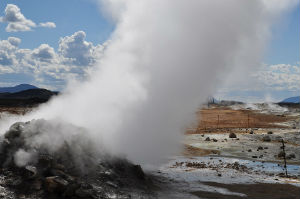Spectacular volcanic eruption provides clues on how tiny aerosol particles influence climate change
22 June 2017

Research showing how clouds respond to atmospheric aerosol will improve climate change predictions
A spectacular six-month Icelandic lava field eruption could provide the key for scientists to understand the role aerosols play in climate change, through their interactions with clouds.
An international team of climate scientists, including the University of Reading, have meticulously studied the effects that the prolonged eruption at Holuhraun, in Iceland had on cloud formations in the surrounding region. The pioneering study is published in leading scientific journal, Nature, on Thursday 22 June.
They found that the Holuhraun fissure eruption, the largest since Laki which erupted in 1782, emitted sulphur dioxide at a higher rate than all 28 European countries added together causing a massive plume of sulphate aerosol particles over the North Atlantic.
As would be expected, these aerosols reduced the size of cloud droplets, but contrary to expectations did not increase the amount of water in the clouds.
The researchers, led by the University of Exeter, believe these startling results could significantly reduce uncertainties in future climate projections by outlining the impact of sulphate aerosols formed from human industrial emissions on climate change.
Volcano was a 'natural laboratory'
Professor Richard Allan, one of the authors at the University of Reading, said: "We used the volcanic eruption in Iceland as a natural laboratory to study how tiny atmospheric aerosol particles affect climate. Our research reveals a smaller than expected effect on clouds and refine estimates of how much aerosol pollution is reducing current warming of the planet.
"This will help to improve predictions of future climate change, which includes more damaging heatwaves, driven by the continued emissions of greenhouse gases from human activities."
Dr Florent Malavelle, lead author of the study and from the University of Exeter said: “The huge volcanic eruption provided the perfect natural experiment in which to calculate the interaction between aerosols and clouds.
“We know that aerosols potentially have a large effect on climate, and particularly through their interactions with clouds. However the magnitude of this effect has been uncertain. This study not only gives us the prospect of ending this uncertainty but, more crucially, offers us the chance to reject a number of existing climate models, which means we can predict future climate change far more accurately than ever before.”
Aerosols play a pivotal role in determining the properties of clouds as they act as the nuclei on which water vapour in the atmosphere condenses to form clouds.
Sulphate aerosol has long been recognised as the most significant atmospheric aerosol from industrial sources, but other natural sources of sulphate aerosol also exist, including that formed from sulphur dioxide release as a result of volcanic eruptions.
Cloud systems 'well buffered' against aerosol changes
The 2014/15 Holuhraun eruption is thought to have emitted between 40,000-100,000 tons of sulphur dioxide every single day during its eruptive phase. Using state-of-the-art climate system models, combined with detailed satellite retrievals supplied by NASA and the Université libre de Bruxelles, the research team were able to study the complex nature of the cloud cover formed as a result of the eruption.
"This will help to improve predictions of future climate change, driven by the continued emissions of greenhouse gases from human activities." - Professor Richard Allan, University of Reading
They found that the size of the water droplets produce was reduced, which in turn led to cloud brightening - which results in an increased fraction of incoming sunlight being reflected back into space and, ultimately, providing a cooling effect on the climate.
Crucially however, these aerosols had no discernible effect on many other cloud properties, including the amount of liquid water that the clouds hold and the cloud amount. The team believe the research shows that cloud systems are “well buffered” against aerosol changes in the atmosphere.
Professor Jim Haywood, co-author of the paper and also from the University of Exeter added: “Explosive and effusive volcanic eruptions are very different. The massive explosive eruption of Pinatubo in 1991, which injected aerosol to altitudes of 25km+ into the stratosphere, has been the go-to event for improving our model simulations of the impact of explosive volcanic eruptions on climate. Now volcanoes have provided a new clue in the climate problem: how aerosols emitted at altitudes similar to those from human emissions impact the climate. Without a doubt, the effusive Holuhraun eruption will become the go-to study in this regard.”
'Strong constraints on aerosol-cloud interactions from volcanic eruptions' is published in Nature, and received funding from the Natural Environment Research Council.
